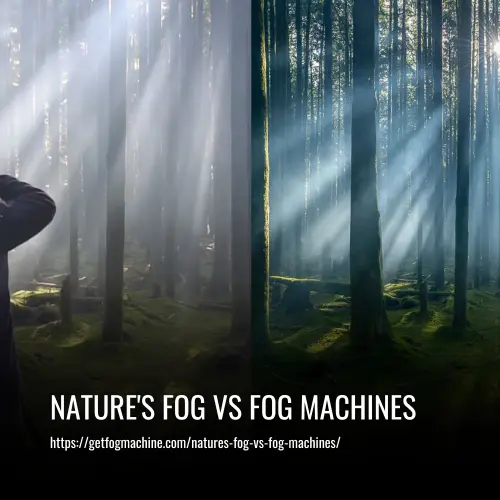Nature’s Fog vs Fog Machines: Which is Better for Your Event?
This post contains affiliate links. As an Amazon Associate, we earn from qualifying purchases.
Natures fog and fog machines both play a key role in creating atmosphere and special effects in various settings. However, there is a huge difference between the two. In this article, we will be exploring the common types of fog machines and their differences, as well as the characteristics and types of natures fog.
We’ll also be discussing the types of fluids used in fog machines and their effects on human health. If you’re interested in learning more about the differences between natures fog and fog machines, their effects, and how they can enhance light beams, intelligent lights, and heat in indoor and outdoor spaces, keep reading.

The Science Behind Natural Fog Formation
Natural fog is a breathtaking meteorological spectacle that occurs when tiny water droplets or ice crystals exist in the air, decreasing visibility significantly. The formation of fog is influenced by temperature and humidity levels to create suitable fog-forming conditions.
1. The Role of Temperature and Humidity
Temperature and humidity are the two essential factors that aid in the formation of fog. Fog comes into the picture when these two factors meet under certain conditions. They create an environment conducive to fog formation. Temperature plays a critical role in this process too.
2. Temperature Influence
When warm air touches cold water or ground surfaces, it rapidly cools down and condenses into small droplets, which form fog. The temperature and surface area of bodies of water also impact fog formation. Fog density varies in thickness, and it reduces visibility based on its density levels.
3. Humidity Factors
Humidity also plays an important role in fog formation. Condensation requires moisture, so if there isn’t enough moisture in the atmosphere, fog won’t form. As a result, humidity affects environmental conditions and plays an important role in creating fog.
How Does Fog Disperse?
The weather changes continuously, and foggy conditions are no exception. When the conditions that initially allowed its formation change, the fog dissipates. A shift in temperature or humidity can cause the tiny water droplets to break up back into vapor form and disperse them back into the atmosphere.
It takes time for this process to occur naturally as daylight warms up surfaces causing higher evaporation rates and consequently breaking down dense patches of fog. Alternatively, wind speeds can also facilitate quicker dispersal by thinning out areas of high humidity and encouraging evaporation.
Exploring The World Of Artificial Fog Production
Creating captivating and otherworldly atmospheres has never been easier, thanks to the advent of artificial fog production. By studying the various techniques and technologies involved, we can unleash the full potential of this exciting tool.
1. The Role of Fog Chemicals
Fog chemicals are integral in generating the desired fog effect. Propylene glycol or glycerin are commonly used, given their non-toxic nature. These substances are mixed with water to form specialized fog fluid. When vaporized by a fog machine, the result is an atmosphere that resembles natural fog.
2. Commercial and DIY Solutions
In addition to commercial fog solutions, DIY alternatives can be concocted using household ingredients like distilled water and food-grade glycerin.
3. Maintaining Fog Machines
Proper maintenance is vital in ensuring optimal performance and longevity of your fog machine. Regular cleaning prevents residue buildup and helps ensure proper functionality. This includes thorough flushing of the system with distilled water after each use, as well as periodic disassembly and cleaning of individual components when necessary.
4. Safety Precautions
Adhering to recommended safety precautions is essential for both health concerns and equipment integrity. Storing chemicals according to manufacturer guidelines, refraining from inhaling directly from the output nozzle, and not leaving machines unattended while in operation are just a few examples.
5. Applications Across Multiple Industries
The use of artificial fog isn’t just confined to concerts or theatrical productions. The film and photography industries frequently employ it as a tool for enhancing depth or creating mood in backdrops. Theme parks use it to simulate eerie environments within attractions. Even emergency response training exercises incorporate controlled amounts of fog for recreating realistic disaster scenarios with compromised visibility.
6. Unlocking The Full Potential
As technology continues to advance, the possibilities for innovative ways to use artificial fog for enriching experiences and adding atmospheric pressure to any situation is limitless.
Pros and Cons of Each Type
When it comes to creating an ethereal and captivating ambiance in your event or project, choosing between natural and artificial fog options can be a daunting task. In this article, we will delve into the advantages and disadvantages of each option to help you make an informed decision.
1. Fog Safety
One of the primary concerns when selecting a fog option is safety. While natural fog occurs naturally and doesn’t involve any added chemicals or substances, artificial fog machines involve heating water and glycol, which can cause irritation in some individuals when exposed for extended periods. As such, it’s essential to consider the potential health implications of each type of fog to ensure you choose an option that aligns with your event’s safety requirements.
2. Fog Aesthetics
The aesthetic aspect of fog is equally essential to consider. Natural fog provides an authentic look and feel for outdoor events or photography projects seeking to capture the essence of nature. On the other hand, artificial fog can be easily controlled, allowing for precise adjustments in density and distribution to create the perfect ambiance or effect required. Depending on your event’s specific needs, you can select an option that aligns with your aesthetic preferences.
3. Visibility Challenges
Both natural and artificial fog can create visibility challenges that you must consider, depending on your specific event requirements. Natural fog varies in intensity based on weather conditions, making it unpredictable, while artificial fog is easily controlled, allowing for the creation of the desired ambiance.
However, if not managed correctly, excessive output levels from fog machines could result in disorientation among attendees. Additionally, if naturally-occurring fogs increase in intensity suddenly, they could disrupt outdoor activities without proper preparation.
Environmental Impacts and Concerns: Natural Fog vs. Fog Machines
Creating the right ambiance or effect in an event can require the use of either natural or artificial fog. Nowadays, it is essential to consider the environmental impacts and concerns when deciding on the best option.

1. Variety of Impacts
Both natural and artificial fog machines have varying effects on climate change, wildlife disruption, air quality, water conservation, and energy consumption. By understanding these factors, any decision made should consider practical and environmentally responsible measures.
2. Ecological Balance
Natural fog plays a critical role in maintaining ecological balance by providing essential moisture to plants and animals and helps regulate temperature. However, climate change may impact natural fog formation, disrupting local ecosystems or causing potential extinction of species that rely on fog to survive.
3. Energy Consumption
Artificial Fog from machines relies heavily on energy consumption for operation, which contributes to greenhouse gas emissions. Also employed are the use of chemicals such as glycerin or propylene glycol that can negatively impact air quality if not correctly managed. While traditional heating-based machines consume more energy than newer ultrasonic counterparts, which require as much as 1 kW per hour usage, they still consume significantly less than most industrial processes or large-scale events such as concerts, where multiple high-wattage devices are deployed simultaneously.
4. Water Consumption
Regarding water conservation, natural fog does not consume additional resources beyond what nature provides. However, artificial methods may require large amounts of water, depending on the specific type of machine in use.
5. Making an Eco-friendly Choice
As you evaluate fog production methods for your event, remember to consider the direct consequences of each method and their impact on the broader ecosystem. Making an eco-friendly choice involves evaluating the potential risks and direct impacts each method has on the environment while also acknowledging their broader implications within our planet’s delicate ecosystem balance system.
Comparing Their Roles in Events and Ecosystems
There’s a distinctive contrast between the natural misty landscapes and the billowing clouds created by artificial fog machines when it comes to events and ecosystems. Both types of fog play unique roles in event aesthetics and ecosystem balance. In this comparison, we’ll explore these roles in depth to provide you with a better understanding.

1. Event Aesthetics
Natural fog can create a mystical or enchanting atmosphere for outdoor events such as weddings, concerts, or photoshoots. It enhances the beauty of the surrounding landscape, making it an ideal choice for outdoor events. Even though natural fog cannot be controlled, it brings its own unique ambiance to any event.
On the other hand, artificial fog generated by fog machines enhances the aesthetics of indoor events such as theater performances, parties, or concerts. Compared to natural fog, artificial fog gives control over the thickness and duration. This control allows for the creation of different effects, making it a popular choice for indoor events.
2. Ecosystem Balance
Foggy weather conditions contribute to a balanced ecosystem by providing moisture that nourishes plant life and helps maintain humidity levels necessary for various wildlife adaptations. Natural fog allows the ecosystem to thrive, and it’s crucial for the survival of the flora and fauna. Additionally, natural fog plays an important role in regulating the temperature of the earth.
Conversely, artificially generated fog does not have any significant impact on ecosystem health, but it may cause local fluctuations in visibility factors due to the use of chemicals in manufacturing the fluid that creates the vapor. This fluctuation can cause disorientation amongst wildlife, creating challenges in their navigation.
3. Health Implications and Wildlife Adaptation
While natural fog is generally harmless (unless it contains pollutants), artificial fog can sometimes pose health risks due to chemicals used in manufacturing the fluid that creates the vapor. This poses a potential threat to people suffering from respiratory issues or allergies. Similarly, studies suggest that artificial fog can disrupt wildlife behavior patterns due to sudden changes in visibility factors.
FAQs
Nature’s Fog refers to fog created naturally in the environment, often occurring in specific weather conditions, such as when warm, moist air meets cooler air or during early morning hours. It’s a result of natural atmospheric processes and can enhance the ambiance of outdoor settings.
Nature’s Fog occurs naturally due to atmospheric conditions, while fog machines generate artificial fog using specific chemicals or solutions. Nature’s Fog is unpredictable and depends on weather conditions, whereas fog machines provide controlled fog production.
Nature’s Fog is generally safer as it is a natural occurrence and does not involve the use of chemicals or artificial additives. Fog machines, on the other hand, may emit chemical-based fog, and prolonged exposure to this artificial fog could potentially cause health issues for some individuals, particularly those sensitive to aerosols or chemicals.
Fog machines attempt to replicate natural fog, but they often produce a different type of fog compared to Nature’s Fog. Nature’s Fog has a unique composition and appearance that may not be entirely replicated by artificial fog machines, although they aim to create similar visual effects.
Nature’s Fog is preferred in outdoor settings, photography, and natural environments where authenticity and a genuine atmospheric feel are desired. It’s also appreciated in landscapes or outdoor events where the unpredictability and natural beauty of fog enhance the ambiance. Fog machines, however, are more suitable for controlled indoor environments like concerts, parties, and theatrical performances where consistent and customizable fog effects are required.
When it comes to fog, there are natural and artificial variations that have distinct differences in their composition and dispersal. Natural fog forms through atmospheric condensation and can linger for hours due to changes in temperature and humidity. On the other hand, artificial fog is created using glycol or glycerin-based solutions and has a shorter lifespan due to their chemical makeup and environmental factors. While artificial fog has benefits like precise control over density and duration for enhancing visual effects, there are potential health hazards to consider if not properly maintained or if low-quality fluids are used.
Conclusion
In conclusion, when it comes to creating a mysterious and eerie atmosphere, natures fog and fog machines both have their benefits. Nature’s fog is naturally occurring and can add a unique touch to outdoor events, but it can also be unpredictable and difficult to control.
On the other hand, fog machines provide reliable and consistent effects, with various types of machines and fluids to choose from to achieve the desired effect. However, it’s important to use the right type of fluid to avoid throat irritation and ensure the safety of those nearby.
Ultimately, the choice between natures fog and fog machines depends on the event and the desired effect. Both can be used to create a stunning atmosphere, whether it’s for a theatrical production, a concert performance, or even just a Halloween party.






